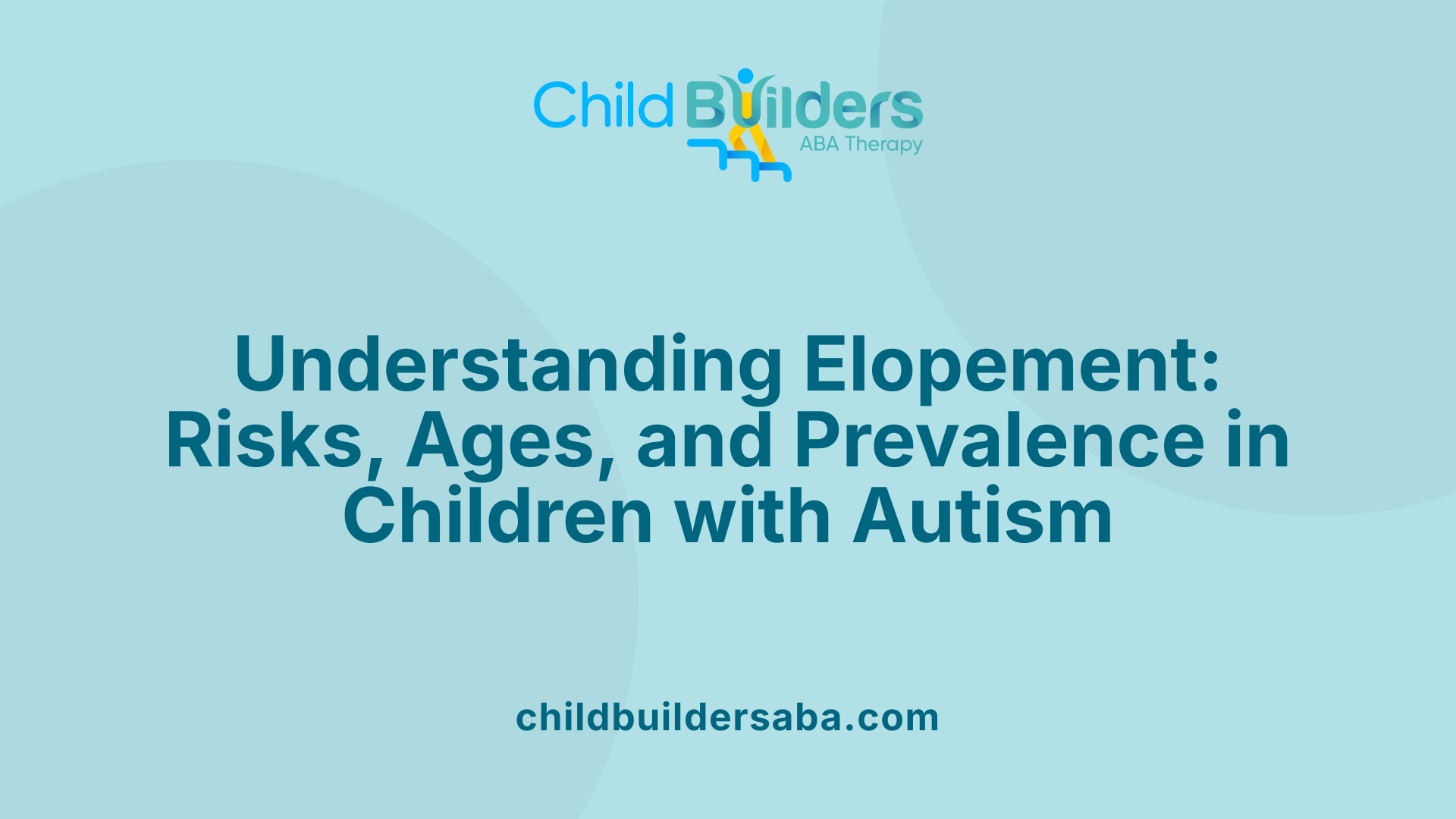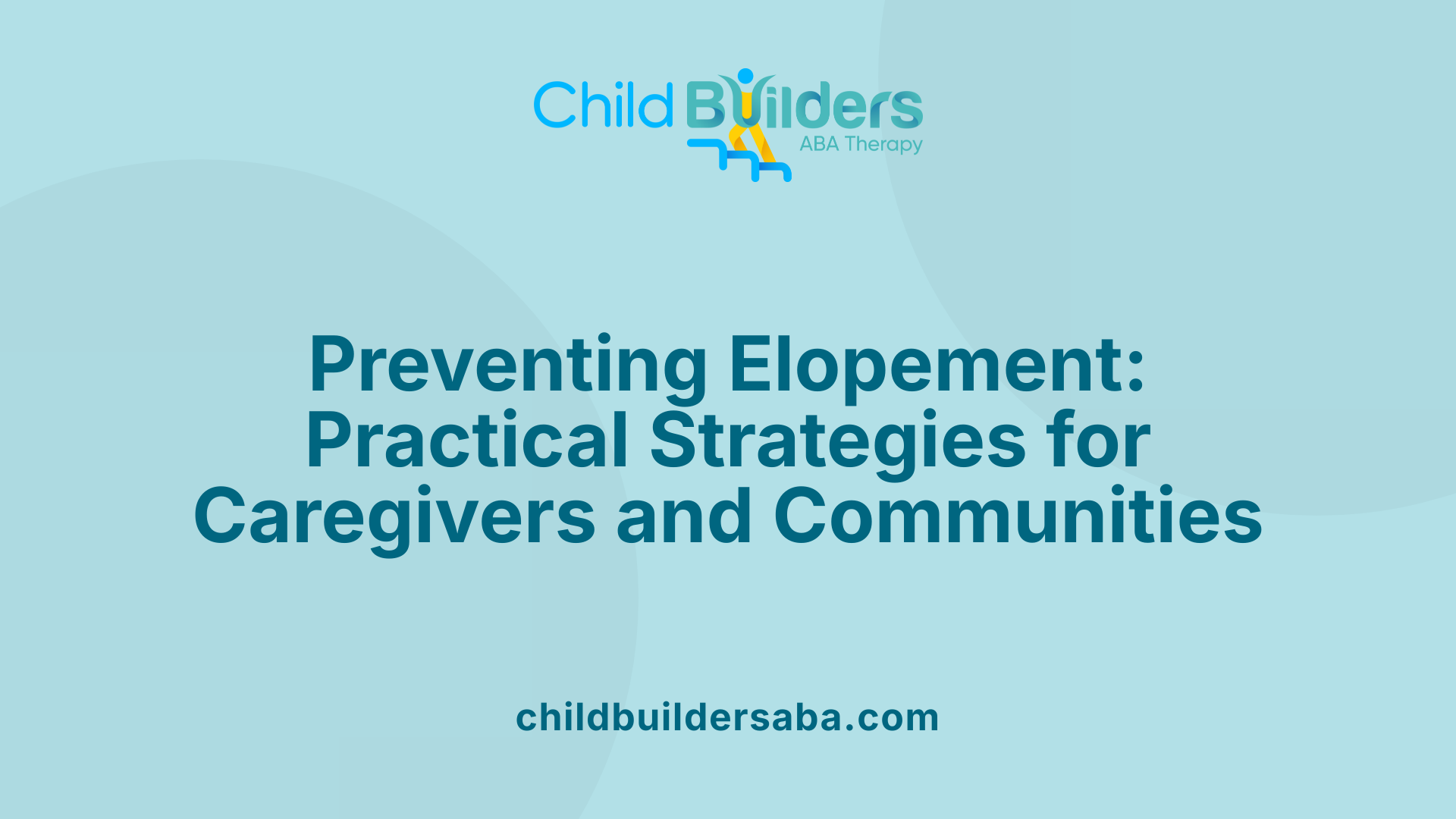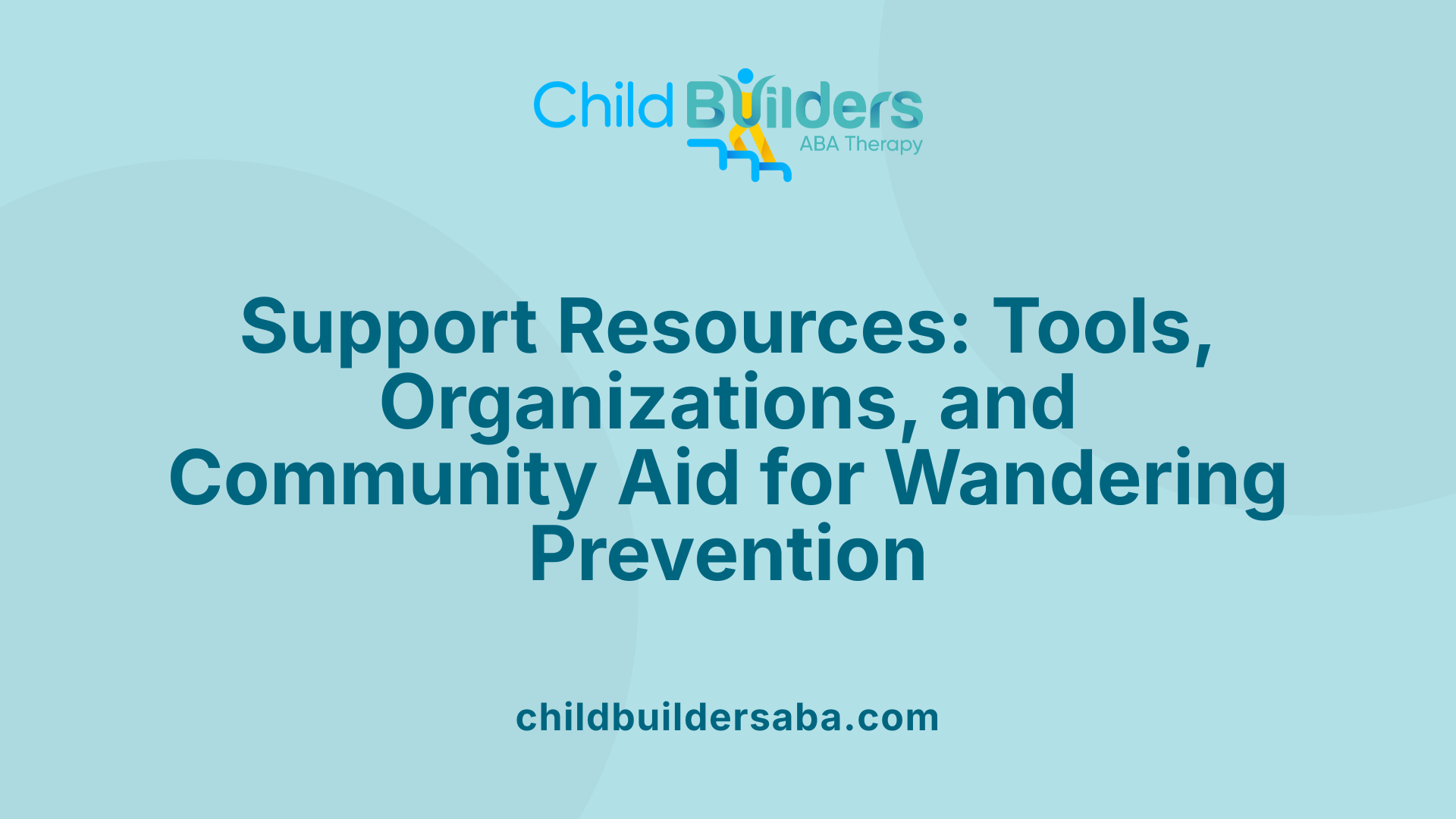Elopement and Autism

Understanding and Addressing Elopement in Autism Spectrum Disorder
Elopement, often termed wandering, is a common and concerning behavior among children with autism. It involves leaving a safe, supervised environment without permission or warning and poses significant safety risks, including drowning, traffic injuries, and exposure to hazardous environments. Recognizing the causes, implementing prevention strategies, and knowing how to respond are essential steps for parents, caregivers, and communities to safeguard these vulnerable individuals.
The Nature and Prevalence of Elopement in Children with Autism

What is the definition of elopement in children with autism?
Elopement in children with autism refers to behaviors such as running away, bolting, or wandering from a supervised, safe environment without warning or permission. This behavior often involves leaving familiar settings like the home, school, or stores. It is typically driven by motivations such as curiosity, sensory seeking or escaping, fleeing from anxiety, or aiming to reach a preferred location.
Children who are at higher risk of elopement tend to have more severe forms of autism, along with communication difficulties and sensory processing issues. This behavior poses serious safety risks, including drowning, traffic-related injuries, and exposure to hazardous surroundings. Because of these dangers, prevention and swift response are crucial.
Strategies to reduce the risks include conducting functional assessments, applying behavioral interventions, and implementing safety measures like securing exits, using GPS trackers, and preparing emergency response plans. These efforts are vital to safeguard children prone to eloping and to prevent tragic accidents.
At what age is elopement most common in children with autism, and do children typically stop eloping as they grow older?
Elopement is most prevalent in children with autism around the ages of 4, with the behavior peaking between approximately 4.4 and 5.4 years old. Studies show that about half of children with autism attempt to elope at least once after age 4, with many experiencing multiple incidents.
Research indicates that roughly 50% of children with autism will try to elope before they turn 18. Although the frequency tends to decrease as children grow older, it remains a persistent concern. Notably, about 30% of children aged 7 to 10 continue to exhibit wandering behaviors.
Factors influencing ongoing elopement include the severity of autism, communication barriers, and sensory issues. Children with more severe symptoms are at a higher risk of continued wandering, which emphasizes the need for ongoing supervision, tailored safety strategies, and behavioral interventions into adolescence. Preventive measures remain essential throughout childhood to reduce potential dangers associated with elopement.
Causes and Triggers of Autism-Related Elopement

What causes elopement in children with autism?
Elopement in children with autism often occurs due to a combination of environmental, emotional, and developmental factors. Causes include distraction, where a child’s attention is diverted from safety, and a desire to go to a favored place or access a special object. Impulsiveness is common, especially in children with lower inhibitory control, leading them to run off without warning.
A significant factor is a lack of danger awareness—many children with autism do not recognize the risks involved in wandering, such as traffic or water hazards. Communication difficulties also play a role; children may not be able to effectively alert others to their needs or intentions, increasing the risk of unsafe situations.
Elopement may also be triggered by various psychological responses. Fight-or-flight reactions are common, especially when children encounter overstimulating or stressful environments. Sometimes, children may wander to escape an undesired situation, such as a noisy setting or a restrictive environment. Curiosity or sensory-seeking behaviors also lead many to explore beyond their safe zones.
Children may wander to fulfill specific needs or impulses—such as seeking sensory stimulation, pursuing a routine activity, or escaping emotional distress. In many cases, behaviors are goal-directed, driven by curiosity, enjoyment, or the desire for independence.
Why do children with autism tend to elope, and what triggers these behaviors?
Children with autism tend to elope for several intertwined reasons. Many attempt to escape situations they find overwhelming or uncomfortable, such as loud noises, crowded places, or unfamiliar routines. This escape behavior is often an immediate response to stress or sensory overload.
Access to objects of interest or people is another motivation. Children may wander to obtain something they desire, whether a toy, a specific location, or to reconnect with loved ones. Additionally, seeking pleasurable experiences or engaging in their favorite activities can motivate wandering, especially if these activities are difficult to access through other means.
Attention-seeking is also a strong trigger. A child might elope to gain interaction or to signal a need for comfort. Fulfilling these desires can provide temporary relief from emotional or physical discomfort.
Environmental triggers play a crucial role. Routine changes, such as a new daily schedule or unfamiliar visitors, can unsettle children, prompting escape attempts. Sensory overload caused by loud noises, bright lights, or overwhelming textures can lead children to seek refuge elsewhere.
Communication hurdles are central to understanding elopement behaviors. Many children with autism have limited ability to communicate their needs or fears, which can result in impulsive actions like fleeing. Recognizing these triggers and understanding individual behaviors are vital for creating effective prevention strategies.
Through tailored interventions that address these causes and triggers, caregivers can better support children with autism, reducing the risks associated with wandering and ensuring their safety.
Prevention Strategies for Autism Elopement

How can parents and caregivers prevent elopement in children with autism?
Parents and caregivers can significantly reduce the risk of elopement by applying a combination of environmental safeguards, behavioral techniques, and community engagement. Securing all exits with locks or alarms is an essential first step. Installing fencing around yards and using door/window covers or sensors can serve as physical barriers.
In addition to environmental safety, wearable GPS devices and identification bracelets offer quick recovery options if a child wanders. These tools are vital, especially in crowded or unfamiliar areas.
Creating a detailed safety plan that involves informing neighbors, local authorities, and emergency services enhances overall safety. Teaching children safety skills, such as responding to their name, recognizing their address, and understanding the importance of staying within safe zones, helps foster independence and awareness.
Behavioral interventions like Functional Communication Training (FCT) help address underlying triggers of wandering, such as communication difficulties or escape-seeking behaviors. Continuous supervision during outings and activities ensures that children are monitored closely, reducing chances of elopement.
By combining these safety measures, education, and community awareness, caregivers can create a supportive environment that minimizes the dangers associated with wandering and elopement.
What are effective behavioral and environmental strategies to treat or prevent wandering?
Effective approaches to prevent wandering include implementing both behavioral and environmental strategies tailored to the child's needs. Visual supports such as social stories and visual schedules can teach children about boundaries, safety, and the importance of staying within designated areas.
Environmental modifications like installing pool fences, securing doors with child-proof locks, and using alarm systems can prevent accidental escapes. Wearable identification devices, including GPS trackers and ID tags, serve as critical tools for rapid location if an escape occurs.
Teaching water safety skills, including swimming lessons, especially with adaptive instruction, is crucial for children at risk of wandering near water bodies. Creating personalized safety plans involving caregivers, community members, and emergency responders enhances overall preparedness.
Addressing underlying motivations for wandering through behavioral interventions reduces the likelihood of incidents. These include positive reinforcement for safe behaviors and teaching alternative coping strategies.
Are there resources available to help parents, teachers, and caregivers prevent and manage autism elopement?
Absolutely. Several organizations provide valuable resources to support families and professionals in managing wandering behavior among children with autism. Autism Speaks, Pathfinders for Autism, and the National Autism Association offer comprehensive safety toolkits, checklists, and educational materials.
These resources include detailed safety tips, such as securing home exits, using GPS tracking devices, and equipping children with identification bracelets. They also offer guidance on teaching safety skills and creating emergency response plans.
Training programs, webinars, and community workshops are available to educate caregivers and professionals about best practices. Some initiatives, like AWAARE, focus on improving first responder awareness and response to wandering incidents.
By utilizing these resources, caregivers can implement effective prevention strategies, reduce risks related to drowning or traffic injuries, and ensure prompt and coordinated responses during emergencies.
Safety Tips and Emergency Response for Wandering Incidents

What safety tips and emergency responses are recommended for managing wandering behaviors in children with autism?
Managing wandering behaviors in children with autism involves a multi-layered approach focused on prevention, safety, and swift emergency response. Since wandering can be life-threatening—particularly due to drowning and traffic injuries—it’s critical to take proactive safety steps.
Home safety is the first line of defense. Secure all possible exits with child-proof locks, covers, and alarms to alert caregivers when a door or window is opened. Installing a sturdy fence around the yard can prevent outdoor escapes, especially in areas near water or busy roads.
Water safety measures are indispensable, given that drowning accounts for nearly half of all injury deaths among children with autism who wander. Teaching children to swim, preferably through adaptive lessons that suit their needs, can be life-saving. Keeping pool covers locked and maintaining constant supervision near water sources helps prevent accidents.
Equipping children with wearable identification devices, such as GPS trackers, smart tags, or ID bracelets with contact information, greatly enhances the chances of a quick, successful recovery if a child wandering away gets lost.
Involving the community is also vital. Inform neighbors, local police, emergency responders, and school personnel about the child's elopement risks. Sharing detailed safety plans and photographs ensures everyone knows how to respond quickly.
Developing an emergency response plan tailored to your child and practicing it regularly can make a significant difference. This plan should include specific steps such as immediately calling emergency services (911), prioritizing water searches if near water bodies, and collaborating with first responders for swift action.
Caregivers should also record recent photographs and unique identifiers of the child to facilitate identification. Alerting community members, such as neighbors and babysitters, about potential wandering behaviors can increase watchfulness.
Emergency services and first responders play a critical role. Providing them with detailed information about the child's needs, tendencies, and the safety tools used—like GPS devices—can minimize response times.
Safety tools, including safety kits and community resources, are invaluable; they often include quick-reference guides for first responders and checklists for caregivers to ensure all safety measures are in place.
In summary, managing wandering in children with autism demands a combination of environmental safety, community engagement, education, and emergency preparedness. Implementing these strategies can reduce the risks and enhance the safety of children prone to elopement, offering peace of mind to families and caregivers.
Resources and Support Networks for Autism Wandering Prevention

Are there resources available to help parents, teachers, and caregivers prevent and manage autism elopement?
Absolutely. There are numerous organizations and programs dedicated to supporting families and caregivers in addressing wandering behaviors among children with autism. These resources aim to reduce risks and ensure swift, effective responses if elopement occurs.
Organizations such as Autism Speaks, the National Autism Association, and Pathfinders for Autism provide a wealth of materials including safety toolkits, checklists, and emergency response plans. These tools help caregivers implement practical safety measures like securing home exits with locks or covers, using wearable GPS devices, and teaching children safety skills such as responding to signals or identifying trusted adults.
In addition to safety kits, these organizations offer educational materials that explain why elopement happens, common triggers, and ways to prevent wandering. They often include guidelines for setting up a secure environment—fencing yards, alert systems, and visual cues to signal safe behavior.
Community awareness plays a crucial role in prevention. Programs like AWAARE (Autism Wandering Awareness Alerts Response Education) work to raise public understanding, involving neighbors, community members, and first responders to recognize and respond appropriately to autistic children who have wandered.
Webinars and training sessions are regularly held for caregivers, teachers, and first responders. These sessions cover topics such as recognizing early signs of wandering, de-escalating situations, and engaging in safe rescue procedures. Many local agencies also collaborate with autism organizations to conduct hands-on workshops, allowing caregivers to practice response techniques.
First responder engagement is a vital component. Specialized training ensures that police, firefighters, and emergency personnel understand autism behaviors and know how to respond safely. These efforts include teaching first responders how to identify children with wearable IDs or trackers, how to communicate effectively during emergencies, and how to perform water rescues safely.
In summary, extensive resources are available to help protect children with autism from the dangers of wandering. These include safety materials, community programs, professional training, and collaboration networks that focus on prevention, preparedness, and quick response to wandering incidents. Utilizing these resources can significantly reduce risks and improve outcomes for children and their families.
Community and Professional Support Strategies
| Resource Type | Description | How It Helps |
|---|---|---|
| Safety Toolkits | Packaged guides with safety tips, checklists, and emergency plans | Helps families secure their homes, teach safety skills, and prepare for emergencies |
| Educational Campaigns | Public awareness programs by organizations like AWAARE | Increases community understanding, encourages neighbors to be watchful |
| Training & Webinars | Sessions for caregivers, teachers, and first responders | Builds response skills and awareness, improving safety and rescue efforts |
| Wearable Identification | Bracelets, tags, or GPS devices for children | Allows quick location if a child wanders away |
| Secure Home Measures | Locks, covers, fencing, alarm systems | Prevents spontaneous escapes and alerts caregivers |
| Community Collaboration | Neighborhood awareness, reporting protocols | Creates a network ready to assist when wandering occurs |
Why Prevention Matters
Studies show that nearly half of children with autism attempt wandering, with significant risks like drowning and traffic accidents. The severity of autism correlates with a higher likelihood of elopement. Therefore, comprehensive safety planning involving these resources is crucial.
By leveraging community awareness, caregiver education, and technological support, families and professionals can work together to minimize these dangers and respond effectively when an incident occurs. The collective effort is essential to safeguard children and reduce anxiety for families navigating autism wandering behaviors.
Implications, Risks, and Long-term Considerations of Autism Elopement
What are the risks associated with elopement, including drowning, traffic injuries, dehydration, and hypothermia?
Elopement poses severe safety risks for individuals with autism, especially those with limited communication skills. Drowning is the most tragic consequence, accounting for approximately 46% of all injury-related deaths in children who wander. Autistic children are 160 times more likely to drown than neurotypical peers, with drowning responsible for 71% of lethal wandering outcomes.
Traffic injuries represent another major danger, with about 18% of injury-related deaths caused by vehicles. Children with autism might impulsively run into streets or unfamiliar environments without awareness of danger.
Other risks include dehydration and heat stroke when Elopers are outdoors for prolonged periods without access to water. Cold exposure or hypothermia can occur if children wander into cold environments, especially in winter.
Falls and encounters with strangers also threaten safety, highlighting the need for constant vigilance. These hazards underscore the importance of comprehensive safety measures and rapid rescue plans for those who attempt to wander.
| Risk Type | Percentage of Deaths | Common Causes | Additional Notes |
|---|---|---|---|
| Drowning | 71% | Water access, impulsive running | Most common cause, and most preventable with water safety skills |
| Traffic injuries | 18% | Street running, distracted crossing | High risk in urban environments |
| Dehydration, hypothermia | Varies | Lack of supervision outdoors | Risks increase with prolonged wandering |
| Falls, injury | Contribute to overall harm | Uneven surfaces, accidents | Preventable with environment modifications |
How does elopement impact family stress and safety?
Families of children with autism face significant emotional stress due to the unpredictable nature of wandering. Fear of injury, drowning, or catastrophic accidents causes ongoing anxiety.
Elopement incidents can lead to feelings of helplessness, guilt, and exhaustion for caregivers. Routines often need to be adapted for heightened safety, increasing daily burdens.
Parents frequently report anxiety about their child's safety, prompting constant supervision and safety planning. Community awareness and neighborhood involvement can help create supportive environments.
In addition to emotional tolls, families must often implement costly safety tools like GPS trackers, secure home modifications, and participate in safety training.
What measures are effective for ongoing management and intervention?
Long-term management strategies are vital for reducing risks associated with wandering. These include environmental modifications such as securing doors and windows with locks or covers, fencing yards, and installing alarm systems.
Behavioral interventions, like functional communication training, help reduce impulsive wandering by teaching children to express needs or fears appropriately.
Technology aids such as GPS tracking devices, smart tags, and wearable IDs enable quick location recovery if a child elopes.
Teaching water safety and survival skills, including swimming lessons adapted for children with disabilities, is strongly recommended.
Community involvement, including informing neighbors and first responders about the child's wandering tendencies, enhances emergency preparedness.
Creating a safe space within the home, using visual routines, and behavioral supports to address anxiety and sensory overload contribute to overall safety.
| Intervention Type | Examples | Purpose | Additional Notes |
|---|---|---|---|
| Environmental modifications | Locks, covers, fencing, alarms | Prevent accidental exit | Ongoing safety, especially during sleep |
| Behavioral strategies | Functional communication, calming routines | Reduce impulsive wandering | Address underlying causes |
| Technology aids | GPS trackers, smart tags | Rapid location and safe retrieval | Must be used with familiarization and caregiver training |
| Education and community engagement | Safety education, neighborhood alerts | Increase awareness and quick response | Critical for rapid intervention |
Do children with autism typically grow out of eloping behaviors or do they tend to continue into adulthood?
Most children with autism tend to reduce eloping behaviors as they grow older, especially with appropriate interventions and safety education. Structured behavioral supports, environmental safeguards, and teaching functional communication skills often help mitigate wandering.
However, some individuals continue to elope into adulthood due to factors like sensory overload, anxiety, routine disruptions, or curiosity. In these cases, the risk persists and may even increase if safety measures are not maintained.
Adult elopement is still dangerous, with risks including injury, getting lost, or exposure to hazardous environments. Since behaviors and triggers may evolve over time, ongoing vigilance is necessary.
Preventive strategies such as technological aids, safety planning, tailored behavioral interventions, and environmental adjustments should be maintained across the lifespan.
While the severity of elopement behaviors often diminishes, they do not always disappear. Long-term safety and ongoing support are essential to protect and empower adults with autism who might still exhibit wandering behaviors.
Ensuring Safety and Empowering Caregivers in Autism Wandering Management
Autism-related elopement poses significant safety risks but can be effectively managed through comprehensive prevention strategies, community awareness, and ongoing education. Understanding the motivations and triggers behind wandering behaviors enables caregivers to implement tailored safety measures, including secure environments, technological aids, and behavioral interventions. Collaboration among families, professionals, and local communities enhances response preparedness, ensuring rapid emergency interventions when needed. As children with autism grow, continued vigilance and adaptive safety plans remain essential, empowering caregivers to protect their loved ones while supporting their independence and well-being.
References
- Elopement Behavior in Kids with Autism
- Autism and Elopement: What You Need To Know About Wandering
- Occurrence and Family Impact of Elopement in Children With Autism ...
- Elopement – What Is It? - Lighthouse Autism Center
- ELOPEMENT PREVENTION CAREGIVERS | The Autism Project
- Wandering - National Autism Association
- Wandering prevention | Autism Speaks
- Wandering - National Autism Association





.jpg)































































































